Translate this page into:
Surgical Pearl: Chemical Ball Pen for Cautery
Address for correspondence: Dr. Muhammed Mukhtar, Mukhtar Skin Centre, Katihar Medical College Road, Katihar 854105, India. E-mail: drmmukhtar20@gmail.com
This is an open access journal, and articles are distributed under the terms of the Creative Commons Attribution-NonCommercial-ShareAlike 4.0 License, which allows others to remix, tweak, and build upon the work non-commercially, as long as appropriate credit is given and the new creations are licensed under the identical terms.
This article was originally published by Wolters Kluwer - Medknow and was migrated to Scientific Scholar after the change of Publisher.
CHALLENGE
Chemical caustic (trichloroacetic acid, phenol) agents are used for cauterizing dermatologic lesions. Its application with ear bud or tooth pick or insulin syringe is not safe because it requires frequent dips and/or attempts. Modified syringes with cotton stuffed tips are good options for chemical cautery; but there are adverse effects of chemicals on needle and piston cap.[12] As a better option, a ball pen with its polytube refill having 0.7 mm or more ball point of non-corrosive stainless steel or brass (which works on rolling movement of ball, not only on capillary action) at its tip is described for precise cauterization on cosmetic site.
SOLUTION
For procuring a chemical refill, an empty refill of a ball pen is used. Its ball point is separated from its refill tube and is washed thoroughly to remove its residual ink with medical spirit and hypochlorite solution. After cleaning and drying, the tube is refilled with chemicals with the help of a syringe after connecting with a small rubber tube used in hematology lab [Figure 1]. The wide bored refill polytube can be refilled directly with the help of syringe if proximal end of the tube snugly fits in the syringe outlet. Then, the metallic ball point of the refill tube is replaced in its position. The other end of the tube is sealed with small cotton ball and packed with superglue to avoid leakage and dryness of chemicals. This chemical refill is set in the pen [Figure 2(A) and (B)]. The residual ink in the ball point, which cannot be washed out properly, gets mixed with chemical agents. So this pen is used first for writing on a paper till color of ink gets vanished. After this, the ball pen is ready to use for cautery. The application of chemical is done by touching as well as rolling with ball pen. The chemical agent is liquid, not as viscous as that of ball pen ink, so it can be mildly sprinkled out. At times, there is need to sprinkle the chemical like fountain pen. Then pen must be covered with a small gauze piece before sprinkling, taking care of skin and clothing. After this, procedure is done initially by touching the skin with ball pen and then with rolling movement of the ball point over the lesions (video). The spots are precise and it has well-controlled flow of chemical [Figures 3(A–E) and 4(A) and (B)]. To procure a chemical pen is easy if we can get the refill with ball point of required diameter. The problem is to clean the refill, particularly ink in its ball point which causes staining of chemicals, which is made easier with sodium hypochlorite solution. The filling of refill and mounting its ball point are easy and safe if done with care. TCA is little corrosive on stainless steel ball point which may affect its flow, but it has no impact on cauterized skin site. After the cautery, the tip of ball pen is washed and moped with medicated spirit, and pen is kept in its stand like a general pen to take care of corrosiveness of chemicals on its ball point.

- The refill polytube is being filled with chemical agents

- (A and B) The refill polytube is set into its pen

- (A–E) The uniform chemical spots of phenol (A and B) and of TCA (C–E) on skin

- (A and B) A patient with multiple freckles precisely cauterized using the chemical ball pen
The limitations of this chemical ball pen are as follows:
In general, the volume of refill is 0.5–0.7 mL, so once refilled, it can be used for 10 to 15 patients or more depending on the number of lesions treated per sitting. So it is better to use on few small and cosmetic site lesions. After the procedure, the ball pen tips should be washed and kept it upside as it may prevent or minimize the corrosive effect of chemical on ball point. Better to use it frequently to avoid the corrosiveness (particularly of TCA) on ball pen tip. On getting the ball point little corrosive along with disturbance in flow of chemical, it could be replaced with another ball point. Thus the reuse of ball pen is a practically good and safe option for chemical cautery for cosmetic lesion.
Declaration of patient consent
The authors certify that they have obtained all appropriate patient consent forms. In the form the patient(s) has/have given his/her/their consent for his/her/their images and other clinical information to be reported in the journal. The patients understand that their names and initials will not be published and due efforts will be made to conceal their identity, but anonymity cannot be guaranteed.
Financial support and sponsorship
Nil.
Conflicts of interest
There are no conflicts of interest.
REFERENCES
- Disposable syringe for chemical cautery. J Am Acad Dermatol 2020 doi: 10.1016/j.jaad.2020.03.120
- [Google Scholar]





